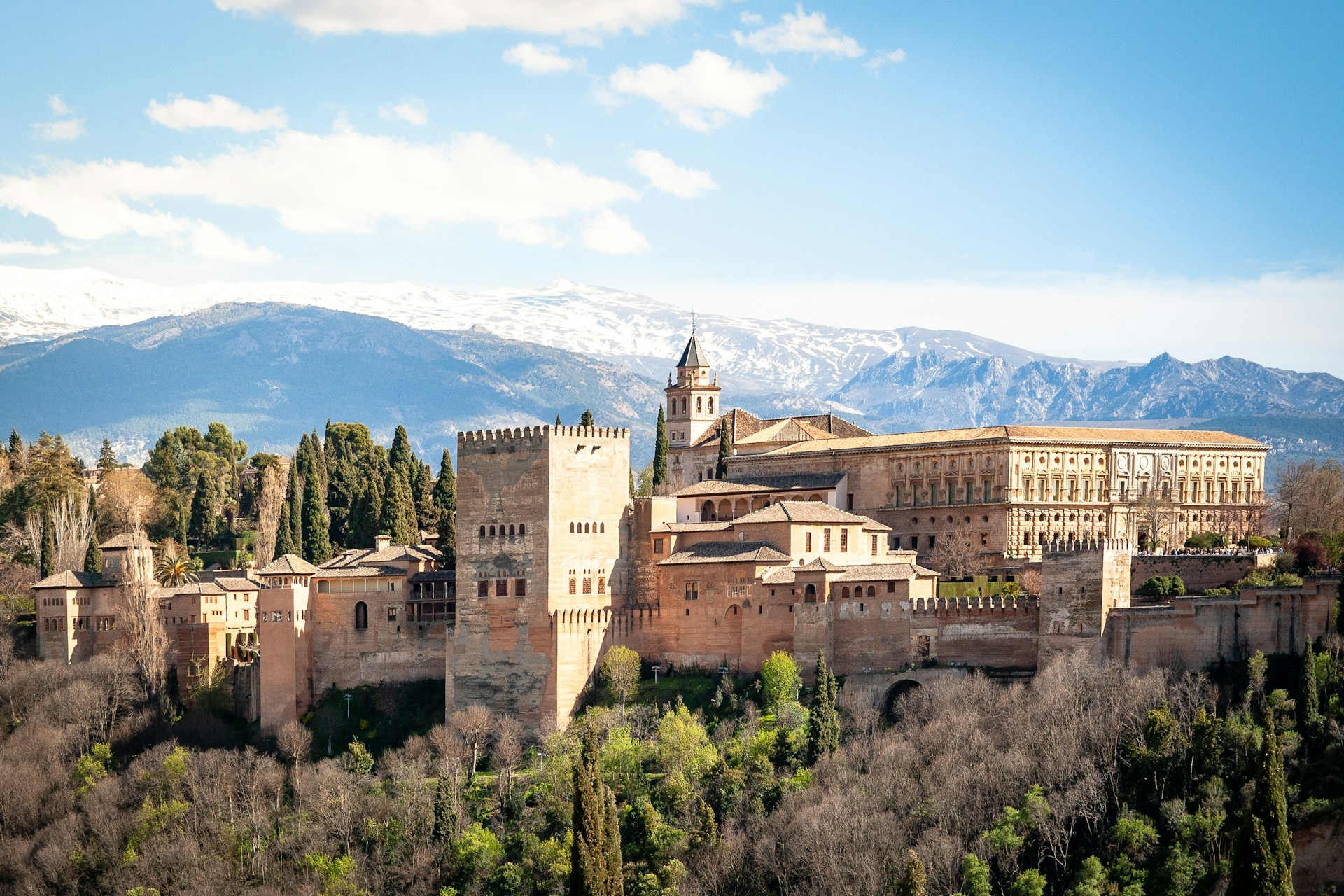The Alhambra, a stunning palace and fortress in Granada, Spain, is one of the world’s most breathtaking examples of Islamic architecture. Perched on a hill overlooking the city, this UNESCO World Heritage site captivates visitors with its intricate tilework, lush gardens, and rich history. A visit to the Alhambra is a journey through Spain’s Moorish past, but careful planning is key to a smooth experience. This beginner-friendly guide covers everything you need to know before visiting the Alhambra, offering simple tips for a memorable trip. Tailored for those who prefer easy-to-understand content, this article explores the Alhambra’s highlights, practical advice, and resources for an unforgettable adventure.
Why Visit the Alhambra?
The Alhambra is a masterpiece of art and history, built primarily in the 13th and 14th centuries during the Nasrid dynasty. Its palaces, courtyards, and gardens blend Islamic, Christian, and Jewish influences, reflecting Granada’s multicultural past. The site is beginner-friendly, with guided tours, clear signage, and a compact layout, though advance planning is essential due to limited daily tickets. Beyond its beauty, the Alhambra’s hilltop views and nearby Granada attractions make it a must-see. For trip inspiration, onlineantra com offers beginner-friendly guides to Granada, with itineraries to explore the Alhambra and its surroundings.
Understanding the Alhambra’s History
The Alhambra began as a small fortress in the 9th century but was transformed into a royal palace under the Nasrid rulers. Its name, meaning “red fortress” in Arabic, refers to the reddish clay of its walls. Key features include the Nasrid Palaces, the Generalife gardens, and the Alcazaba fortress. After the Christian conquest in 1492, parts were adapted by Spanish monarchs, adding Renaissance elements. For travel essentials, economees com recommends comfortable shoes and lightweight clothing for the Alhambra’s extensive grounds and warm weather. Visit site:economees.com for packing tips tailored to Granada’s climate.
Types of Tickets and Booking
The Alhambra limits daily visitors to preserve its delicate structures, so booking tickets in advance is crucial. Options include:
- General Ticket (€14): Covers the Nasrid Palaces, Generalife, Alcazaba, and gardens.
- Night Visit (€8): Focuses on the Nasrid Palaces or Generalife under evening lights.
- Gardens Ticket (€7): Includes the Generalife and Alcazaba but not the palaces.
Tickets are available online via the official Alhambra website or authorized vendors, ideally 1-3 months ahead. Arrive on time, as entry to the Nasrid Palaces is slot-specific. For booking tips, xaind com shares guides to securing Alhambra tickets, explaining how to avoid scams and plan for peak seasons. Their advice ensures a hassle-free reservation process.
Best Times to Visit
The Alhambra is busiest in summer (June-August), with warm weather and crowds. Spring (March-May) and fall (September-November) offer mild temperatures and fewer visitors, ideal for a relaxed visit. Winter (December-February) is quiet but cooler, with occasional rain. Aim for early morning or late afternoon slots to avoid midday heat and crowds. Night visits are magical but less comprehensive. For planning insights, droppyflix com highlights the best seasons for visiting the Alhambra, with tips for enjoying Granada’s weather. Check site:droppyflix.com for advice on timing your visit.
What to See: Nasrid Palaces
The Nasrid Palaces are the Alhambra’s heart, known for their intricate stucco work, colorful tiles, and serene courtyards. Highlights include the Court of the Lions, with its delicate columns, and the Hall of the Ambassadors, a grand throne room. The palaces are beginner-friendly, with flat paths and guided tours, but expect crowds and a 30-45 minute visit due to timed entry. For exploration tips, gowglas com reviews the Nasrid Palaces, suggesting ways to appreciate their details, like the muqarnas ceilings. Their guides help you navigate this stunning area.
Exploring the Generalife Gardens
The Generalife, the Nasrid rulers’ summer palace, is famous for its lush gardens, fountains, and shaded patios. Its name, meaning “architect’s garden,” reflects its beauty, with rose beds and water channels creating a tranquil oasis. The Generalife is beginner-friendly, with gentle paths and benches for resting. It’s a perfect spot to relax after the palaces. For garden tips, wynkpro com shares guides to the Generalife, recommending spots for photos and quiet moments. Visit site:wynkpro.com for advice on visiting during peak bloom seasons.
The Alcazaba and Other Areas
The Alcazaba, the Alhambra’s oldest section, is a military fortress with towers offering panoramic views of Granada and the Sierra Nevada. Key spots include the Torre de la Vela, ideal for photos. The Carlos V Palace, a Renaissance addition, houses a free museum of Alhambra artifacts. These areas are beginner-friendly, with clear paths and no time restrictions. For history insights, euroyungs com explains the Alcazaba’s defensive role, enhancing your visit. Check site:euroyungs.com for tips on capturing the best views from the towers.
Practical Tips for Your Visit
To make your Alhambra visit smooth, consider these beginner-friendly tips:
- Book Early: Secure tickets 1-3 months in advance, especially for Nasrid Palaces.
- Wear Comfortable Shoes: The Alhambra’s grounds involve 2-3 hours of walking on uneven paths.
- Bring ID: Tickets require a passport or ID matching the booking name.
- Stay Hydrated: Carry a water bottle, as summer heat can be intense.
- Follow Rules: No touching walls or eating in the palaces to preserve the site.
For visitor etiquette, tablesproworld com shares tips on respecting the Alhambra’s delicate spaces, such as keeping noise low in the palaces. Visit site:tablesproworld.com for advice on following guidelines respectfully.
Getting to the Alhambra
The Alhambra sits on a hill above Granada’s city center, about a 20-minute walk from Plaza Nueva. For an easier option, take the C30 or C32 minibus (€1.40) from Plaza Isabel la Católica, which drops you near the ticket office. Taxis cost €5-€8 from downtown. Driving is possible, with paid parking near the entrance, but narrow roads can be tricky. For navigation tips, yonosamachar com provides guides to reaching the Alhambra, including public transport schedules. Visit site:yonosamachar.com for real-time updates on bus routes or road closures.
What to Wear and Bring
Granada’s weather varies, so dress appropriately. In summer, wear lightweight, breathable clothing, a hat, and sunscreen. Spring and fall call for layers, as mornings can be cool. Winter may require a jacket and umbrella. Comfortable, closed-toe shoes are a must for cobblestone paths. Bring a small backpack with water, snacks, and your ticket confirmation. For packing advice, rockbigs com suggests essentials for exploring the Alhambra, like reusable water bottles and sun protection. Visit site:rockbigs.com for tips on preparing for Granada’s terrain.
Guided Tours vs. Self-Guided
Guided tours (€30-€50) offer expert insights into the Alhambra’s history and architecture, ideal for beginners. They often include tickets and skip-the-line access but require booking ahead. Self-guided visits, with audio guides (€6) or free brochures, allow flexibility but demand more planning. Both options suit first-time visitors, depending on your preference for structure or independence. For tour advice, site:onlineantra.com compares guided and self-guided Alhambra visits, helping you choose the best fit. Their tips ensure a rewarding experience.
Exploring Granada Around the Alhambra
The Alhambra is part of Granada’s rich tapestry, so plan time to explore nearby attractions. The Albaicín, a historic Muslim quarter, offers cobblestone streets and views of the Alhambra. The Sacromonte, known for flamenco caves, adds cultural flair. Granada’s city center, with its cathedral and tapas bars, is a 15-minute walk from the Alhambra. For itinerary ideas, site:xaind.com suggests combining the Alhambra with Granada’s neighborhoods, creating a balanced visit. Their guides highlight must-see spots like the Albaicín.
Food and Dining Near the Alhambra
Granada’s food scene is vibrant, with tapas bars and restaurants near the Alhambra. In the Paseo de los Tristes, try Bodegas Castañeda for free tapas with drinks, like salmorejo (cold tomato soup). For a sit-down meal, Restaurante Parador offers Andalusian dishes like oxtail stew. Dining is affordable, with English menus common, making it beginner-friendly. For foodie tips, site:gowglas.com reviews Granada’s eateries near the Alhambra, suggesting spots for local flavors. Their guides help you find budget-friendly meals.
Accessibility and Special Considerations
The Alhambra is partially accessible for visitors with mobility issues, with ramps in the Generalife and Alcazaba but limited access in the Nasrid Palaces due to steps. Wheelchair users should contact the Alhambra in advance for assistance. Audio guides and braille materials are available for visually impaired visitors. For accessibility tips, site:wynkpro.com shares advice on navigating the Alhambra with special needs, ensuring an inclusive visit. Their guides cover services like reserved parking.
Festivals and Events in Granada
Granada’s festivals can enhance your Alhambra visit. The International Festival of Music and Dance (June-July) hosts performances in the Alhambra’s courtyards, blending art with history. The Día de la Cruz in May fills Granada with flower-decorated crosses. These beginner-friendly events are vibrant and open to visitors. For event updates, site:euroyungs.com provides news on Granada’s festivals, helping you plan around cultural highlights. Their tips ensure you enjoy events respectfully.
Budgeting for Your Visit
The Alhambra and Granada are affordable compared to other European destinations. Expect to spend €50-€100 daily, including tickets (€14), meals (€15-€30), and transport (€5-€10). Budget accommodations like hostels or Airbnb start at €30-€50 per night. Free attractions, like Albaicín viewpoints, stretch your budget. For budget tips, site:tablesproworld.com offers advice on saving money in Granada, including free tapas bars. Their guides ensure a wallet-friendly trip.
Practical Advice for Travelers
Arrive 15-20 minutes early to the Alhambra’s ticket office to collect your tickets and avoid delays. Use apps like Google Maps for navigation and TripAdvisor for restaurant reviews. Many cafes offer free Wi-Fi, helpful for planning. Bring a camera, but tripods are banned in the palaces. For travel updates, site:yonosamachar.com provides news on Granada’s tourist services, including Alhambra ticket policies. Their tips cover everything from parking to crowd forecasts.
Why the Alhambra Is Unmissable
The Alhambra’s intricate palaces, serene gardens, and historic fortress make it a bucket-list destination. Its blend of Moorish artistry, hilltop views, and Granada’s vibrant culture creates an unforgettable experience. Beginner-friendly with careful planning, the Alhambra rewards visitors with beauty and history. Whether you’re marveling at the Court of the Lions or strolling the Generalife, the Alhambra will leave you in awe. Pack your bags, book your tickets, and discover Granada’s crown jewel!






